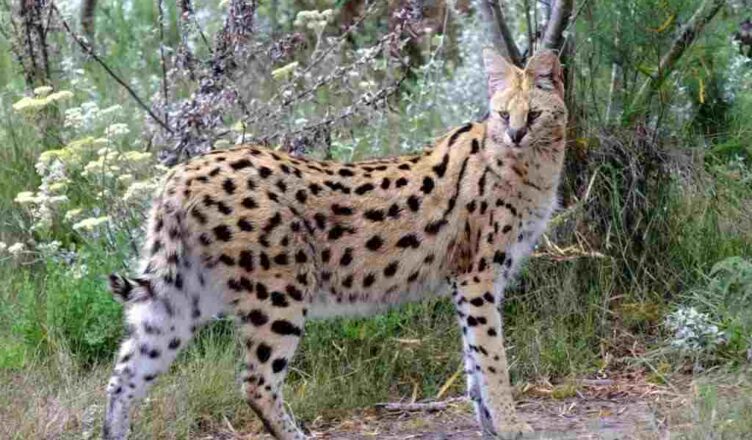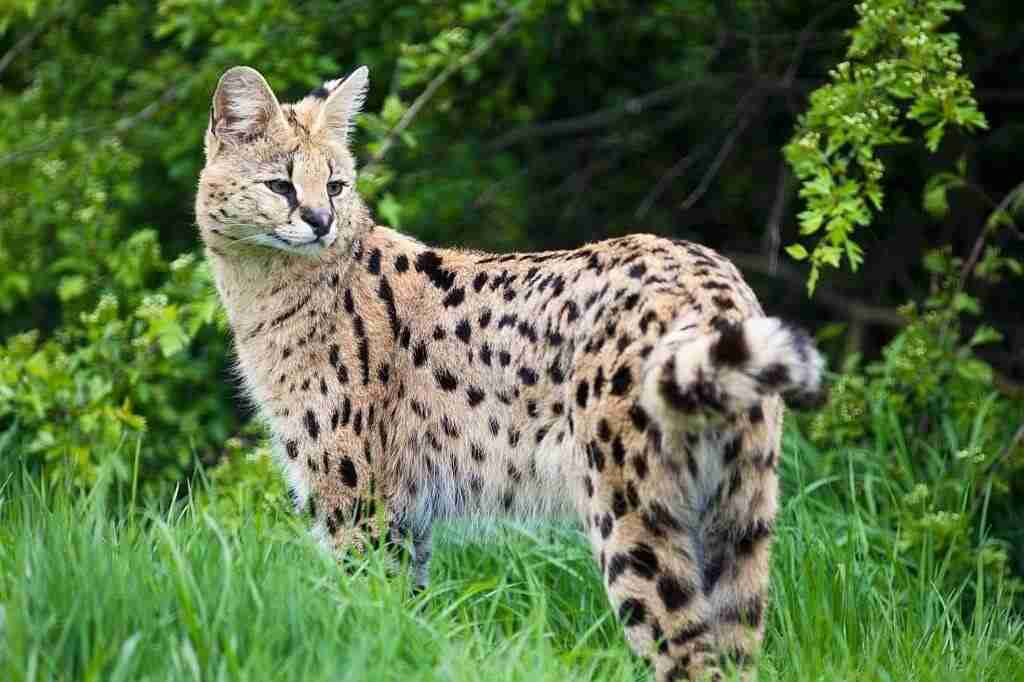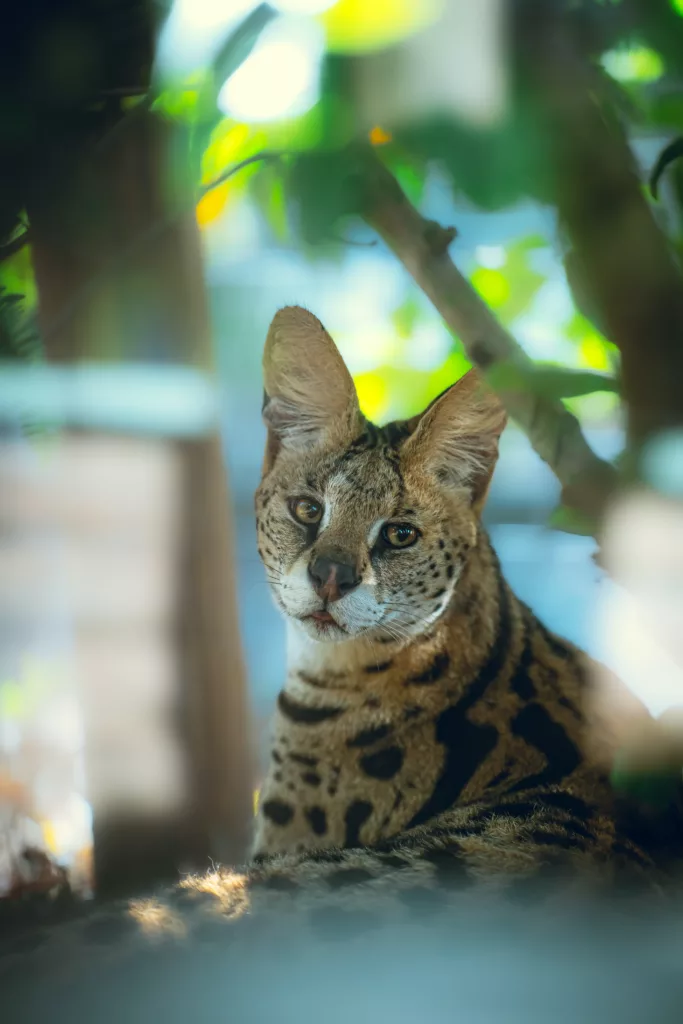Ever laid eyes on a serval cat? They are the coolest cats in the world! The serval is one of Africa’s most unusual and biggest cats. Servals live in grasslands, scrublands, savannas, and dense forests on both sides of the equator.
Don’t miss your chance to meet the ultimate feline sensation!
In some countries, they are hunted because people think they will attack livestock or humans.
But in reality, that is not true at all! Servals eat rodents like rats and mice, so they won’t come to your house looking for food (they have better things to do).
A serval can leap an incredible 12 feet in the air, so catching one is no simple task. Therefore, if you see one, keep in mind to offer it kindness rather than animosity. Not gloves, but some love.
Breed Overview
| Attribute | Description |
|---|---|
| Scientific Name | Leptailurus serval |
| Origin | Native to Africa; primarily found in grasslands, wetlands, and savannas. |
| Weight | 20 to 40 pounds |
| Behavior | Protective and solitary; highly skilled hunter. |
| Diet | Carnivorous; primarily eats rodents, birds, frogs, and insects. |
| Physical Characteristics | Long legs, large ears, and a slender body. |
| Coat Patterns | Spotted; usually golden-yellow with black spots and stripes. |
| Lifespan | Typically around 10 to 12 years in the wild; can live up to 20 years in captivity. |
| Eye Color | Amber |
Serval Cat Characteristics
The serval cat has several distinguishing features that make it unique from other cats, such as their long legs, large ears, and spotted patterning on its fur coat.
The most typical coloration of the serval cats are;
- Golden-Yellow with Black Stripes and Spots: The most typical serval coloring is a golden-yellow coat that is adorned with black patterns.
- Melanistic: A genetic mutation known as melanism causes certain servals to be totally black.
- White Spots (Ocelli): Servals frequently have white markings (ocelli) on the back of their ears, which are considered to be “follow-me” signals for young kittens.
- Leucistic: Extremely uncommon servals that are leucistic have a partial lack of pigmentation, giving them a lighter or even white coat. Leucism does not change the color of the eyes like albinism does.
Servals also have larger-than-average paws, which come in handy when they need to tear apart their prey for sustenance.
Serval Personality
A serval cat is one of the most fascinating creatures in the world. It has some interesting personality traits like, it is very vocal animal and often makes loud sounds to attract attention or communicate with other pride members.
Instead of hissing like a regular housecat, they growl when they get angry – which can be terrifying for those who don’t know how it sounds!
Serval cats also have an interesting way of communicating with each other by rubbing their back on another animal’s fur as if saying “hello” or “goodbye.” If you’re lucky enough to find yourself living near a serval.
Serval cat is not a common house pet
It’s important to note that serval cats are considered unfamiliar pets and may require special permits or licenses in some areas.
Additionally, serval cats are not recommended for everyone and require specialized care and attention, so it’s important to research the breed thoroughly before considering purchasing one.
This cat is not a common house pet. They are, however, very interesting and beautiful animals that you could see at the zoo or safari park. The Serval is native to Africa, and they have been known to be used as pets in some parts of Asia.
If you’re interested in getting your pet serval, please consult an expert before making any decisions because these animals can be quite expensive, and specialized care might be required over time.
Domestic Serval Cat
The domestic serval cat is a hybrid cat that was first bred in the 1980s. It was originally created to combine the features of its parents, a wild African serval and an American shorthair.
They are often called “genetic freaks” for their unique appearance and personality traits.
Serval Cat Lifespan
Servals in the wild normally live for 10 to 12 years, however some can live much longer. They may survive up to 20 years or more in captivity if given the right care, nutrition, and medical treatment.
With no other predators on their heels like lions or leopards, these cats do not need to hunt down prey every day, resulting in less stress on their bodies.
They also have more access to food since people often feed them by hand while living at home with them. They also usually get better medical care than what is available out in the wild, so their lifespans are cut short due to infections or illnesses that could easily be treated if found early enough.
Serval Cat Price
The price of serval cats ranges from $3,000 to $10,000 and more. Same as the Maine Coon cat, serval cat price varies depending on various factors such as age, gender, breeding, and location of the breeder or seller.
Male servals are usually more expensive than females, and servals that come from reputable breeders and have exceptional bloodlines can also be more expensive.
Difference Between Savannah and Serval Cat
Savannah and Serval cats are two distinct breeds of cats that have several differences in terms of their physical characteristics, temperament, and breeding history.
Physical Characteristics
Serval cats are a wild cat species found in Africa and are larger than Savannah cats. They have golden or yellow coats with black spots and stripes, large ears, and long legs.
Savannah cats, on the other hand, are a hybrid breed of domestic cats and servals.
They have a smaller, leaner body type and a spotted or marbled coat. They have large, upright ears and longer legs than most domestic cats.
Temperament
Serval cats are wild animals that have been domesticated to some extent but still have strong instincts, making them difficult to train as pets. They are typically more aloof and independent than domestic cats and may require more space and attention.
On the other hand, Savannah cats are bred specifically to be petted and are typically more social and friendly than servals. They can be trained to walk on a leash and enjoy playing fetch.
Breeding History
Serval cats have not been bred with domestic cats for as long as Savannah cats have. Savannah cats were first bred in the 1980s by crossing African servals with African domestic cats.
The goal was to create a new cat breed with the unfamiliar look of a serval but a more domesticated temperament. This breeding program has continued for several decades, resulting in several generations of Savannah cats.
Can a serval cat kill a human?
No, a serval cat cannot kill a human. Although serval cats are fierce hunters of small animals, they cannot kill a human. While they are unlikely to pose a lethal threat, they may still cause injury if they feel threatened or cornered.
It is crucial to remember that keeping wild animals like servals as pets is generally not recommended. Because of the risks associated with their behavior and the difficulty in providing appropriate care and environment.
What is a Serval?
A Serval is a wild African cat prominent by means of its substantive coat, lengthy legs, and massive ears. It best exists in sub-Saharan Africa.
Are Serval cats house pets?
Servals are wild creatures, but some people also maintain them as unusual pets. Although they’re not domesticated like other house cats.
What many years do Serval cats live?
Servals generally stay up to ten years in the wild. With the proper care, they may live for up to twenty years in captivity.
What ingredients do Serval cats eat?
Servals are predators that typically hunt insects, rodents, birds, and frogs. In captivity, they’re frequently given a specific diet.
Always exercise caution around wild animals and respect their natural habitats.




